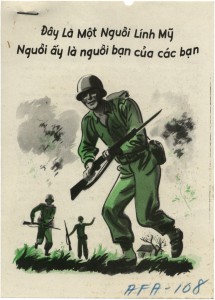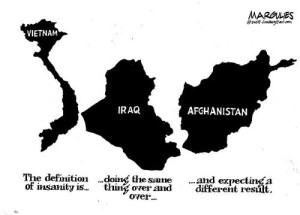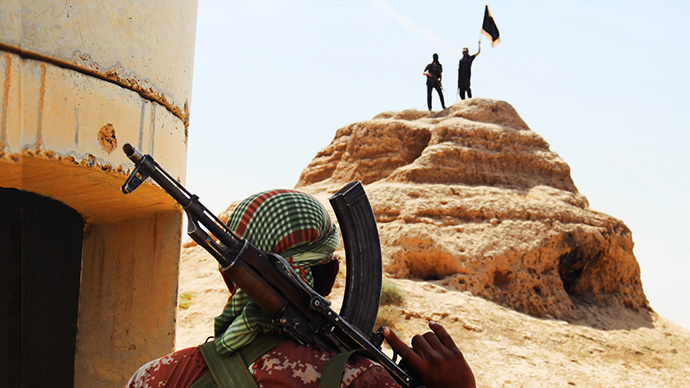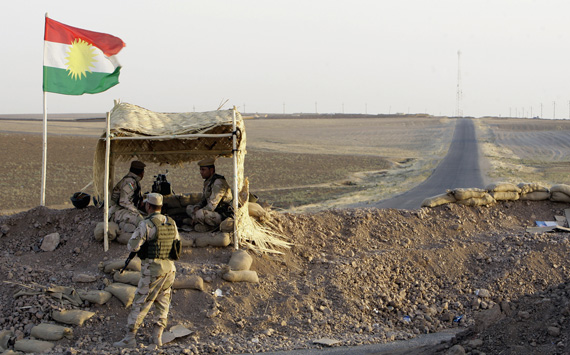Counterinsurgency (COIN) doctrine emerged in the United States as an alternative tactical approach to the conflict in Vietnam. With the recent rise of irregular and asymmetric warfare, COIN has been resurrected as an effective approach for dealing with insurgency where conventional warfare tactics cannot, as in Iraq and Afghanistan. The effectiveness of the approach, however, is questionable. The United States’ first foray into counterinsurgency in Vietnam was disastrous on many levels, and the COIN movement in Afghanistan has not proven to be very effective either; this despite previous experience in Vietnam and Iraq which led to a major reimagining of the doctrine. This failure is largely due to a disconnect between the theory and the practice of COIN, which has arisen in part because of entrenched and institutionalized attitudes within the traditional military structure.
It is not difficult to see why counterinsurgency tactics may be supported by government officials; counterinsurgency doctrine in theory proposes a political solution to insurgency that involves winning the “hearts and minds” of the population and building community support. However, in practice counterinsurgency tactics have failed, and have even backfired by paving the way for insurgents to garner support where they previously had none. The failure of American COIN can be seen by examining the birth of counterinsurgency tactics in Vietnam and their current application in Afghanistan.
COIN tactics differ from conventional warfare. The types of conflicts that encourage counterinsurgency are typically those where the problem cannot be solved by purely military means; political, social, and economic solutions are required as well. Insurgencies tend to be characterized by non-conventional armed forces. These groups use their local knowledge of terrain and some degree of popular support to compensate for their lack of advanced technology and manpower that characterizes large professional militaries like that of the United States. As insurgents use the local population to achieve their ends, their opponents cannot fall back on a more conventional “army vs. army” strategy. Thus, in order to defeat an insurgency, tacticians believe it is necessary to “win over” the civilian population in order to deprive insurgents of popular support and gain local knowledge. Counterinsurgency is thus essentially a tactical framework for “winning the hearts and minds”, by engaging in violence against insurgents with minimal civilian casualties, delivering public services to civilians, and instigating government reform. While counterinsurgency tactics seem attractive in theory, in practice COIN has not proven very effective.
COIN cannot be effective if the counterinsurgents are killing more civilians than the insurgents themselves.
When the United States deployed its military to Vietnam, President Kennedy wanted to approach the conflict in a way that would distance the United States from the neo-colonial sentiments that fuelled criticisms of the intervention. It was the hope of the Kennedy administration that a reimagined strategy would allow for the defeat of the insurgency without the blemish of imperialism. At the start of America’s involvement in Vietnam, the concept of counterinsurgency was promoted as a method not only of military victory, but of social, political, and economic change by some of Kennedy’s closest advisors. Counterinsurgency as a tactic seemed to be less military and more in the vein of state-building as the Kennedy administration wanted to build a new Vietnam from the ground up that could eventually become an independent American ally; another piece on the board in the Cold War against the Soviet Union without the shadow of colonialism.

However, despite the high hopes for a reinvented counterinsurgency, America’s adventures in Vietnam were an unequivocal failure. Counterinsurgency tactics as they were applied in Vietnam failed to comprehend the subtleties of the politicization of the Vietnamese population, nor the strong ties between insurgents and the civilian populace. Proponents of the counterinsurgency approach in Vietnam envisioned the deployment of small local units designed to build up America-friendly Vietnamese defense forces. However, in a stark example of the deviation of practice from theory, this failed to emerge. While President Kennedy and several high level bureaucrats embraced the notion of counterinsurgency, the Department of Defense was more sceptical, and indeed looked disdainfully on the concept. The stubborn adherence to conventional warfare tactics on the part of the Pentagon and the unwillingness, or inability, of President Kennedy to push back against the conventional school of thought with policy change resulted in a mixture of conventional warfare and counterinsurgency tactics in Vietnam.
These conflictual tactical theories led to an aspiration to prevail in the war by winning over the civilian populace, but a contradictory practical application of brute force and high-tech firepower. The institutional conservatism of the American military guided the application of force in Vietnam, leading to an intense air-bombing campaign that killed droves of civilians as well as insurgents. One of the major failures of COIN in Vietnam was with the air-bombings of heavily populated areas in an effort to wipe out insurgents, killing many civilians and breeding animosity towards the Americans in the process. Tactics that victimize civilians are likely to provoke an intense reaction against the counterinsurgents, and the indiscriminate bombing of rural Vietnam provoked anti-American sentiment. COIN cannot be effective if the counterinsurgents are killing more civilians than the insurgents themselves. It is difficult for a military to win the hearts and minds of a population that they are simultaneously victimizing.
It seems clear that in Vietnam, the disconnect between American policy and military strategy resulted in a conventional war of attrition being fought under the banner of counterinsurgency. This divide has its roots in the institutional culture of the American military. As John Nagl argues: “an army that saw its raison d’être as winning wars through the application of firepower and maneuver to annihilate enemy forces simply could not conceive of another kind of war in which its weapons, technology, and organization not only could not find the enemy, but usually could not even find or identify him”. Tactical manuals are relatively easy to rewrite, but the shift in culture that had to take place at all levels of the military was not so quick to occur. The stubbornly ingrained culture of equating firepower with victory worked against the American presence in Vietnam, and they ultimately failed to encourage the development of a pro-Western regime.
After the failure of Vietnam, COIN fell out of favour amongst the American military bureaucracy. Counterinsurgency was intellectually tied to a type of warfare that the United States no longer wanted to be associated with – nonconventional, peripheral, small conflicts. However, after the collapse of the Soviet Union and the end of the Cold War, American military planners began to contemplate engagement practices for low-level conflicts in lieu of a superpower rivalry. COIN did not come back into American military doctrine in a meaningful way until the wars in Iraq and Afghanistan. These conflicts will be explored in more depth in the second part of this series.





